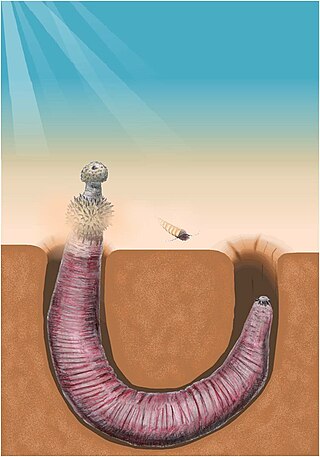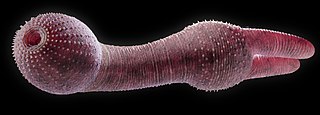
Priapulida, sometimes referred to as penis worms, is a phylum of unsegmented marine worms. The name of the phylum relates to the Greek god of fertility, because their general shape and their extensible spiny introvert (eversible) proboscis may resemble the shape of a human penis. They live in the mud and in comparatively shallow waters up to 90 metres (300 ft) deep. Some species show a remarkable tolerance for hydrogen sulfide, anoxia and low salinity. Halicryptus spinulosus appears to prefer brackish shallow waters. They can be quite abundant in some areas. In an Alaskan bay as many as 85 adult individuals of Priapulus caudatus per square meter has been recorded, while the density of its larvae can be as high as 58,000 per square meter.

Ottoia is a stem-group archaeopriapulid worm known from Cambrian fossils. Although priapulid-like worms from various Cambrian deposits are often referred to Ottoia on spurious grounds, the only clear Ottoia macrofossils come from the Burgess Shale of British Columbia, which was deposited 508 million years ago. Microfossils extend the record of Ottoia throughout the Western Canada Sedimentary Basin, from the mid- to late- Cambrian. A few fossil finds are also known from China.

Treptichnus is the preserved burrow of an animal. As such, it is regarded as the earliest widespread complex trace fossil. Its earliest appearance, around 542 mya, which was contemporaneous with the last of the Ediacaran biota, is used to help define the dividing line, considered geologically at 541 mya, between the Ediacaran and Cambrian periods. It is last seen in the fossil record during the Cenomanian.
Fieldia is a genus of worms known from the Cambrian Burgess Shale, and assigned to the priapulids.

Ancalagon minor is an extinct priapulid worm known from the Cambrian Burgess Shale.

Archaeopriapulida is a group of priapulid worms known from Cambrian lagerstätte. The group is closely related to, and very similar to, the modern Priapulids. It is unclear whether it is mono- or polyphyletic. Despite a remarkable morphological similarity to their modern cousins, they fall outside of the priapulid crown group, which is not unambiguously represented in the fossil record until the Carboniferous. In addition to well-preserved body fossils, remains of several archaeopriapulid taxa are known to have been preserved primarily as organic microfossils, such as isolated scalids and pharyngeal teeth. They are probably closely related or paraphyletic to the palaeoscolecids; the relationship between these basal worms is somewhat unresolved.

The palaeoscolecids are a group of extinct ecdysozoan worms resembling armoured priapulids. They are known from the Lower Cambrian to the late Silurian; they are mainly found as disarticulated sclerites, but are also preserved in many of the Cambrian lagerstätten. They take their name from the typifying genus Palaeoscolex. Other genera include Cricocosmia from the Lower Cambrian Chengjiang biota. Their taxonomic affinities within Ecdysozoa have been the subject of debate.

Selkirkia is a genus of predatory, tubicolous priapulid worms known from the Middle Cambrian Burgess Shale, Ogygopsis Shale and Puncoviscana Formation. 142 specimens of Selkirkia are known from the Greater Phyllopod bed, where they comprise 0.27% of the community. In the Burgess Shale, 20% of the tapering, organic-walled tubes are preserved with the worm inside them, whereas the other 80% are empty. Whilst alive, the tubes were probably vertical, whereas trilobite-occupied tubes are horizontal.
Scolecofurca is a genus of stem-group priapulid worm dating from the Middle Cambrian period approximately 505 million years ago.
Lecythioscopa is a genus of probable archaeopriapulid known from two specimens from the Walcott Quarry from the Middle Cambrian Burgess Shale.

Omnidens amplus, meaning "large all-tooth", is an extinct species of large Cambrian animal known only from a series of large mouth apparatus, originally mistaken as the mouthparts of anomalocaridids. When first named, it was interpreted as a giant priapulid, but is now considered a panarthropod. Its mouth apparatus closely resembles that of the smaller gilled lobopodian Pambdelurion, indicating it is likely to have been a close relative of that species, with which it may be synonymous. With a maximum estimated body length of 1.5 metres (4.9 ft), Omnidens is suggested to have been the largest known free-living Cambrian organism. Omnidens fossils are found in the Maotianshan Shales.

Small carbonaceous fossils (SCFs) are sub-millimetric organic remains of organisms preserved in sedimentary strata.
Archotuba is a genus of elongated conical tubes that were seemingly deposited by colonial organisms. Known from the Chengjiang, its biological affinity is uncertain; it somewhat resembles the tubes of the 'priapulid' Selkirkia, but a cnidarian affinity is also possible. In the absence of soft parts, there really isn't enough data to confirm a biological affiliation.

Priapulidae is the canonical family of priapulid worms, comprising Priapulus and Priapulosis as well as the Carboniferous genus Priapulites.

Xiaoheiqingella is a taxon of priapulid known from the Chengjiang biota; synonymous with Yunnanpriapulus, and thought to belong to the priapulid crown group.

Paraselkirkia is a genus of archaeopriapulid known from the Chengjiang biota, resembling Selkirkia.
Corynetis is a genus of archaeopriapulid known from the Chengjiang biota, and a senior synonym of Anningvermis multispinosus.
Eopriapulites is an early taxon in the priapulid total group, known from orsten-type material at the Kuanchuanpu Formation of China.
Mikko Kokkonen is a Finnish professional ice hockey defenceman who is currently playing with the Toronto Marlies in the American Hockey League (AHL) as a prospect under contract to the Toronto Maple Leafs of the National Hockey League (NHL). He was selected 84th overall by the Maple Leafs in the 2019 NHL Entry Draft.
Olivooides is an extinct, sphere-shaped microfossil from Cambrian strata. Fossils are currently known only from China. Olivooides was approximately 600‐870 μm in diameter. It was an egg with a large yolk content. Fossils from Shaanxi, China can be found in the cleavage, gastrulation, organogenesis, cuticularization, pre‐hatching, post‐hatching and subsequent growth stages of development. This fossil is a result of soft-bodied preservation. Olivooides has pentaradial symmetry and is usually preserved by calcium phosphate endocast. The internal structure is rarely preserved. It has no larval stage, so it likely had a quick and direct development.












